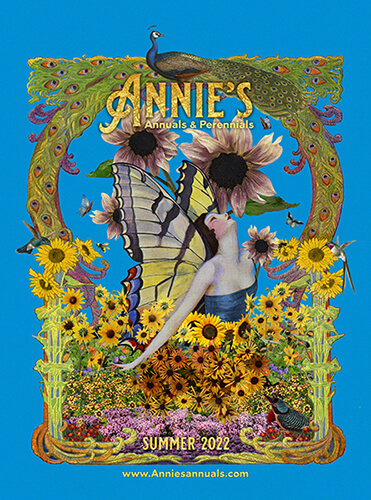|
|
|
Aquilegia caerulea
'Rose Queen'
Intense, dark rosy pink outer petals contrast beautifully with white centers on 2” wide, long-spurred blooms. Makes a great cut flower and a nice addition to woodland gardens, sunny rock gardens, and cottage gardens. 2’x2’ when in bloom, which is all spring long.
Perennial USDA Zones 3-10
|
Abutilon
'Talini's Pink'
Large and delicious, pendulous big pink blooms, to 3" across, that are non-stop throughout the year. 'Talini's Pink' is easy, vigorous and fast growing to 6' x 5', with a dense and graceful branching pattern and attractive evergreen maple-like foliage. Happiest in rich, loamy soil, with a 2” layer of compost each spring and fall.
Perennial USDA Zones 9-10
|
|
|
|
Rudbeckia hirta
'Chim Chiminee'
A delightfully unexpected surprise is yours when you grow this easy but hard-to-find “Black-Eyed-Susan”. Long single or semi-double quilled petals radiate from a large central disc to form extra big blooms to 6” across! Blooms in an array of colors (and bicolors), from sunny yellow to ruby red. Blooms July-frost on branching stems to 30”. Self-sows freely so you’ll get all the colors.
Short-lived Perennial USDA Zones 5-10
|
Tagetes lemmonii
"Mexican Marigold"
EASY EASY EASY, and almost ever-blooming but especially in winter! 2” bright yellow marigold-esque flowers bloom on a 4’x6’ somewhat sprawling shrub. Renowned for its musky mint scent. Tolerates clay and fairly non-fertile soils. Exceptionally deer resistant and drought tolerant once established. Prune to shape and size.
Perennial USDA zones 8-11
|
|
|
|
Solanum valerianum
'Navidad, Jalisco'
Fast growing, evergreen and almost ever-blooming, with large 8-12" panicles of starry purple flowers accented with pillowy yellow anthers. This vine with its Wisteria-style long sweeping stems, will easily fill in to cover a wall or fence in a year or two. Flowers appear from spring to December. Doesn't climb by tendrils, so you do have to provide something for it to climb on. Deer resistant and not fussy about soil or water, but it will be more exuberant with compost enhanced soil and somewhat regular water.
Perennial USDA Zones 9b-11
|
Scabiosa atropurpurea
'Florist's Blue'
A single plant can produce over a hundred of these sweetly scented, 2” spherical “pincushions.” This ‘Sunburst’ strain was selected for its large, dense blooms and long and sturdy branching stems that make perfect cut flowers, lasting up to 2 weeks in a vase! The more you cut, the longer it blooms. Rich soil a must! 30”-36” tall. Reseeds! Great habitat plant.
Perennial USDA zones 9-11
(Annual elsewhere)
|
|
|
|
Ceanothus thyrsiflorus
'Skylark'
'Skylark' is compact, densely branching and has a long bloom season. Fast growing to 3-5’ tall and a bit wider, this evergreen shrub is easy to use as an accent in smaller spaces or as a groundcover or even a hedge. Abundant clusters of fragrant cerulean blue flowers burst into a breathtaking display from spring into summer, and often again in fall in cooler climates. Tolerates heat, clayish soil and summer water better than most “California Lilacs” and is quite frost hardy to 5-10°F.
CA Native Perennial USDA Zones 6b-10
|
Aster novae-angliae
'Harrington's Pink'
Profuse clusters of charming 1” finely rayed soft pink blooms appear on well-branched sprays mid-late summer thru fall. To 4-6’ tall and to 3’ across, it’s a good idea to pinch it back in June for a bushier habit. Tough, mildew resistant and long-lived, it’s also tolerant of CLAYISH soil and salt conditions. Best in rich soil. Awesome cut flowers and deer and rabbit resistant!
Perennial USDA Zones 4-10a
|
|
|
Cirsium occidentale
"Cobweb Thistle"
An amazing (non weedy!) California native thistle with bright cherry 1-2” bloom heads that pop out from possibly the most striking flower buds ever. Ghostly white cobwebby things are held on long stems well above wooly & wavy silver-white leaves. Grows naturally on hot, dry slopes so provide well-drained soil or grow in a container. Great color & texture to mix with native grasses or native annuals. Prefers non-fertile soil. Attracts butterflies. Easy! Deer resistant. To 3’ x 2’. Deciduous in colder zones.
Due to Agricultural Restrictions we cannot ship this plant to Arkansas.
Short Lived Perennial USDA Zones 7-10
|
|
|
|
Artemisia californica
'Canyon Grey'
This prostrate form of “California Sagebrush” features silvery aromatic foliage that is delightfully fuzzy. Staying under one foot tall and spreading to 4’ wide, it’s an excellent ground cover in a dry bed. Tough as nails but beautiful, it adds a silvery glow to any sunny bed and combines well with other drought tolerant natives. The finely cut foliage sprouts small white flowers in summer. Highly adaptable to a wide range of habitats if given good drainage. Deer resistant.
CA Native Perennial USDA Zones 7-10
|
Echium wildpretii
"Tower of Jewels"
One of the coolest plants we can grow here on the West Coast! Other-wordly conical clusters of glistening reddish pink flowers can reach 8’ and will certainly get your garden noticed! Deer resistant, bug proof and totally drought tolerant “Tower of Jewels” seems not to care about anything but looking stupendous! Usually blooms in year 2. Adored by hummers, it self-sows for years of enjoyment! Poor dry soil okay, but not clay.
Biennial USDA Zones 9-10
|
|
|
|
Vitis
'Emeryville Pink'
Thanks to California Rare Fruit Growers, we offer you the best grape for coastal gardening. Sweetening right up here in our fog zone, ‘Emeryville Pink’ bears an abundance of flavorful mid-size pink fruit with seeds so tiny, there’s no need to spit them out. Grows 6-8’ its first year and then takes off in year two, giving you plenty to harvest. We've been growing it successfully for years on our nursery fence and it's always a beloved seasonal snack for visitors and employees alike!
Due to Agricultural Restrictions we cannot ship this plant to Ohio.
Perennial Vine USDA Zones 7-11
|
Vitis californica x vinifera
'Roger's Red'
A large deciduous climber known for its spectacular riotous red fall color. In growth however, the leaves are rounded and a dull gray green. This selection is actually a first generation hybrid between our native grape (Vitis californica) and a non-native wine grape (Vitis vinifera). So, though it is not a true, unadulterated native, it’s just as lovely and deserving of a place in the garden. The grapes it produces are seedy but edible and attract wildlife. They also can be used to make jelly! Grows to 30-40’ fairly quickly. Though Vitis californica is often found along the banks of streams, it can get by with very little water and long periods of drought once established.
Perennial Vine USDA Zones 7-10
|
|

